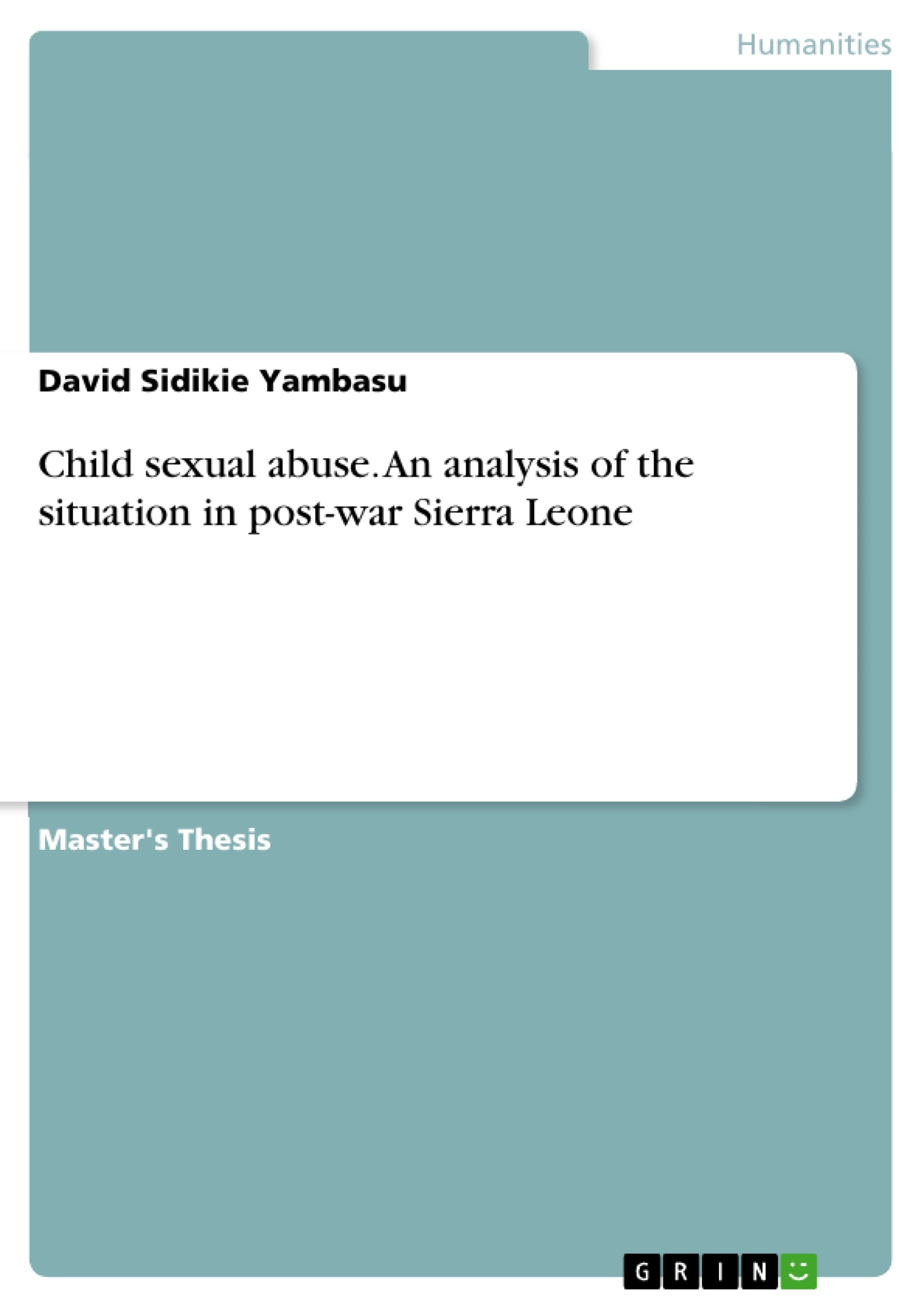Despite its responsibility to protect the citizens of the state, getting government to account, intervene, prevent and respond to the human rights violations including child sexual abuse is a critical challenge to NGOs, and CSOs who should be working in partnership with government to protect children from sexual abuse. This study seeks to explore these challenges in a post-conflict environment where civil authority and social structure have been destroyed and to suggest possible ways of improving the interventions, preventions and response strategies used by the government and NGOs within a culture context.
Child sexual abuse is not a particular phenomenon to post–war Sierra Leone, but a common feature of most war-torn African countries. It is one of the most pervasive human rights challenges in post–war reconstruction and development. But the magnitude of the problem is often underestimated as most incidents of sexual abuse go unreported which is character of environments were the culture of silence is dominant. Although child sexual abuse predates civil wars, it is aggravated by breakdown of law and other created by the armed conflict which has physical, emotional and psychological effects on the child victims.
Globally, child abuse is one of the most pervasive human rights challenges but not often given the desired attention it deserves. Where states fail to uphold their obligation to protect children from abuse, they remain "silent victims’’. In conflict situations such as in DR Congo, Liberia and Ivory Coast, children are prone to systematic exploitation including sexual exploitation and abuse (SEA), rape, neglect, abduction and conscription. For example, the zeid investigations of SEA allegations levied against UN peacekeepers in DR congo concluded that of the 105 cases of SEA committed by peacekeepers who were mandated to protect the vulnerable population, 45% were against girls below 18 years.
In 2002, similar allegations were also made against UN workers and peacekeepers in West Africa who were working with refugees and internally displaced women and children, a situation that brought the UN under disrepute. It is estimated that about 275 million children are potential victims of sexual violence. This may be an underestimation as most incidents of sexual violence go unreported.
Inhaltsverzeichnis (Table of Contents)
- Chapter One: Introduction
- 1.1 Overview of study
- 1.2 Sierra Leone civil war and impact on children
- 1.3 Conceptual framework for analysis
- 1.4 Methodology
- 1.5 Definition of terms and concepts
- 1.6 Organisation of work
- Chapter Two: Conceptualising Child Sexual Abuse
- 2.1 Introduction
- 2.2 Child sexual abuse
- 2.3 Impact of sexual abuse on children
- 2.4 Child Sexual Abuse and International Protection Instruments
- 2.5 Key domestic protection instruments
- 2.6 Conclusions
- Chapter Three: Understanding child sexual abuse in post Sierra Leone
- 3.1 Introduction
- 3.2 Extent of the problems
- 3.3 Child sexual abuse within families
- 3.4 Child sexual abuse in communities
- 3.5 Child sexual abuse in institutions
- 3.5.1 Residential care
- 3.5.2 Detention centres
- 3.5.3 Educational institutions
- 3.6 Child commercial sex exploitation
- 3.7 Accountability
- 3.8 Conclusions
- Chapter Four: Interventions, preventions and responses to child sexual abuse
- 4.1 Introduction
- 4.1.1. Interventions by government
- 4.1.2 Government's prevention strategies
- 4.1.3 government's response strategies
- 4.2 NGO related interventions, preventions and responses
- 4.2.1 NGO interventions and preventions
- 4.2.2 NGO response to child sexual abuse
- 4.3 Traditional and socio-cultural implications
- 4.4 Conclusions
- Chapter Five: Key finding and concluding recommendation
- 5.1 Key finding
- 5.2 Recommendations
Zielsetzung und Themenschwerpunkte (Objectives and Key Themes)
This study investigates the challenges of child protection, specifically focusing on child sexual abuse, in post-war Sierra Leone. It aims to explore the impact of the civil war on child vulnerability and the effectiveness of interventions, prevention, and response strategies employed by the government and NGOs. The study also aims to identify key challenges hindering effective protection and propose recommendations for improvement.
- Impact of war on child vulnerability
- Prevalence and nature of child sexual abuse
- Role of government and NGOs in child protection
- Challenges to effective child protection
- Recommendations for improving interventions, preventions, and response strategies
Zusammenfassung der Kapitel (Chapter Summaries)
Chapter One introduces the study, outlining its scope, context, and research methodology. It explores the impact of the Sierra Leone civil war on children and establishes a conceptual framework for analysis. Chapter Two examines the concept of child sexual abuse, exploring its impact on victims, international and domestic legal instruments for protection, and the prevalence of the issue in post-war Sierra Leone. Chapter Three delves into the specific challenges faced by child protection efforts in the post-conflict environment, analyzing the extent of the problem across different contexts, including families, communities, and institutions. Chapter Four examines interventions, preventions, and responses implemented by both the government and NGOs, assessing their effectiveness and identifying limitations.
Schlüsselwörter (Keywords)
This study focuses on the challenges of child protection in post-war Sierra Leone, specifically investigating the issue of child sexual abuse. Key terms include child protection, sexual abuse and exploitation, victims, perpetrators, human rights, protection instruments, responsibility, violence, rape, Ministry of Social Welfare Gender and Children’s Affairs, non-governmental organizations, civil society organizations, interventions, preventions, and responses. The study also explores the impact of the Sierra Leone civil war on children, and the complexities of navigating a culture of silence.
- Citar trabajo
- David Sidikie Yambasu (Autor), 2008, Child sexual abuse. An analysis of the situation in post-war Sierra Leone, Múnich, GRIN Verlag, https://www.grin.com/document/462602



